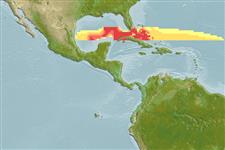Teleostei (teleosts) >
Myctophiformes (Lanternfishes) >
Myctophidae (Lanternfishes) > Diaphinae
Etymology: Diaphus: Greek, dis, dia = through + Greek, physa, phyo = to beget, to have as offspring (Ref. 45335).
Environment: milieu / climate zone / depth range / distribution range
Ecology
Marine; bathypelagic; depth range ? - 476 m (Ref. 26282). Deep-water; 26°N - 22°N
Western Atlantic: Cuba.
Size / Weight / Age
Maturity: Lm ? range ? - ? cm
Minimum depth from Ref. 58018.
Life cycle and mating behavior
Maturity | Reproduction | Spawning | Eggs | Fecundity | Larvae
Claro, R., 1994. Características generales de la ictiofauna. p. 55-70. In R. Claro (ed.) Ecología de los peces marinos de Cuba. Instituto de Oceanología Academia de Ciencias de Cuba and Centro de Investigaciones de Quintana Roo. (Ref. 26340)
IUCN Red List Status (Ref. 130435: Version 2024-1)
Threat to humans
Harmless
Human uses
Tools
Special reports
Download XML
Internet sources
Estimates based on models
Preferred temperature (Ref.
123201): 20.6 - 26.4, mean 23.2 °C (based on 25 cells).
Phylogenetic diversity index (Ref.
82804): PD
50 = 0.5000 [Uniqueness, from 0.5 = low to 2.0 = high].
Bayesian length-weight: a=0.01122 (0.00358 - 0.03515), b=2.99 (2.74 - 3.24), in cm total length, based on LWR estimates for this (Sub)family-body shape (Ref.
93245).
Trophic level (Ref.
69278): 3.1 ±0.3 se; based on size and trophs of closest relatives
Resilience (Ref.
120179): High, minimum population doubling time less than 15 months (Preliminary K or Fecundity.).
Fishing Vulnerability (Ref.
59153): Low vulnerability (10 of 100).
